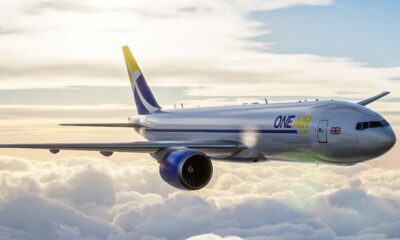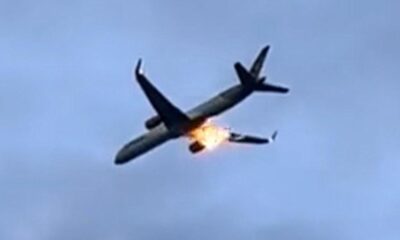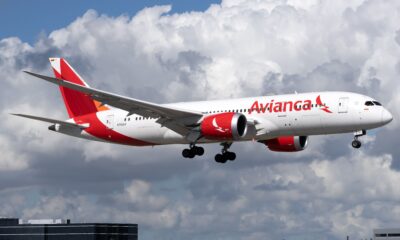Science
Examining the C-17 Globemaster III’s Notable Asymmetry

Aviation design typically emphasizes symmetry, focusing on balanced structures to enhance aerodynamics and flight performance. However, the Boeing C-17 Globemaster III has gained attention for its unique asymmetrical features, particularly in its under-fuselage sponsons that house the landing gear. As reported by The War Zone in September 2025, the right sponson is longer than the left, a design choice that has sparked both curiosity and discussion among aviation enthusiasts.
The C-17’s right sponson accommodates several essential components, including the auxiliary power unit (APU) which supports various systems such as electricity, hydraulics, and environmental controls. The asymmetric shape arises because the APU is positioned within the right sponson, necessitating a longer design compared to its left counterpart. Observers have noted that this length discrepancy becomes particularly visible from specific angles, especially when viewed from below.
Despite its asymmetry, the C-17 is engineered to maintain performance and stability. The aircraft features structural reinforcements and aerodynamic adjustments to ensure that the variation does not adversely affect its handling capabilities. The careful design mitigates any potential issues that might arise from the uneven weight distribution.
Historical Context of Asymmetry in Aviation
Asymmetrical aircraft are not a novel concept. Historical examples date back to the 1930s and World War II, when designers experimented with unconventional layouts to enhance functionality. The German manufacturer Blohm & Voss became notable for its innovative designs, such as the BV 141, which featured an offset engine nacelle for improved visibility. Although the Luftwaffe ultimately favored the more conventional Focke-Wulf Fw 189, the BV 141 demonstrated effective stability and performance despite its unusual appearance.
Other Blohm & Voss projects included the jet-powered P.178 and P.194, which utilized asymmetric thrust and mixed propulsion layouts. These prototypes showcased the potential benefits of asymmetry while highlighting the challenges of managing yaw control and aerodynamic drag.
Beyond Blohm & Voss, other wartime aircraft incorporated asymmetrical features. The Heinkel He 111 and the Bristol Blenheim both featured offset cockpit designs to enhance pilot visibility. These examples underline that asymmetry can be practical and effective when thoughtfully integrated into aircraft design.
Modern Applications and Experimental Designs
Post-World War II, several experimental designs continued to explore the possibilities of asymmetry. Notably, Burt Rutan designed the Rutan Boomerang, a twin-engine light aircraft first flown in 1996. The Boomerang featured offset engines and varying wing geometries to improve safety in the event of an engine failure.
Additionally, NASA’s AD-1 tested the concept of an oblique wing, where one wing was swept forward and the other backward. This research provided valuable data on asymmetric lift and drag distributions, further pushing the boundaries of conventional design.
Some production aircraft also embraced asymmetry, including the A-10 Thunderbolt II, known for its off-center GAU-8 Avenger cannon. The aircraft’s nose landing gear was similarly offset to balance the forces generated by the cannon. The de Havilland Sea Vixen and English Electric Canberra PR.9 also featured distinct asymmetrical designs that enhanced their operational capabilities.
In the realm of civil aviation, the Hawker Siddeley Trident stands out for its offset nose landing gear, which was necessitated by the need for space to accommodate avionics and other systems. This design decision illustrates how practical constraints can drive asymmetrical features in civil aircraft without compromising safety or performance.
Asymmetry in aircraft design is dictated by several factors, primarily the need for balance between lift, weight, thrust, and drag. Engineers often implement compensatory measures, such as adjusting wing span or utilizing trimming surfaces, to counteract the effects of asymmetry. The physics behind flight requires meticulous attention to these details, ensuring that the aircraft performs predictably and efficiently.
Looking forward, asymmetry may find new applications in drone technology and specialized platforms where unique layouts confer distinct advantages. Nevertheless, mainstream commercial aviation will likely continue to favor symmetrical designs, providing reassurance to operators and passengers alike regarding stability and reliability.
-

 Entertainment3 months ago
Entertainment3 months agoAnn Ming Reflects on ITV’s ‘I Fought the Law’ Drama
-

 Entertainment4 months ago
Entertainment4 months agoKate Garraway Sells £2 Million Home Amid Financial Struggles
-

 Health3 months ago
Health3 months agoKatie Price Faces New Health Concerns After Cancer Symptoms Resurface
-

 Entertainment3 months ago
Entertainment3 months agoCoronation Street’s Carl Webster Faces Trouble with New Affairs
-

 Entertainment2 months ago
Entertainment2 months agoWhere is Tinder Swindler Simon Leviev? Latest Updates Revealed
-

 Entertainment4 months ago
Entertainment4 months agoMarkiplier Addresses AI Controversy During Livestream Response
-

 Science1 month ago
Science1 month agoBrian Cox Addresses Claims of Alien Probe in 3I/ATLAS Discovery
-

 Entertainment4 months ago
Entertainment4 months agoKim Cattrall Posts Cryptic Message After HBO’s Sequel Cancellation
-

 Entertainment2 months ago
Entertainment2 months agoOlivia Attwood Opens Up About Fallout with Former Best Friend
-

 Entertainment3 months ago
Entertainment3 months agoMasterChef Faces Turmoil as Tom Kerridge Withdraws from Hosting Role
-

 Entertainment4 months ago
Entertainment4 months agoSpeculation Surrounds Home and Away as Cast Departures Mount
-

 World2 months ago
World2 months agoCole Palmer’s Mysterious Message to Kobbie Mainoo Sparks Speculation

















